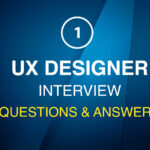We are gathered interview questions and answers from qualified from UX Designers
We have curated a collection of insightful interview questions and expert responses from qualified UX Designers. Explore valuable insights and perspectives to enhance your understanding of the UX design field.
During a UX designer job interview, you can expect a range of questions aimed at assessing your skills, experience, and problem-solving abilities. Below are some common UX designer interview questions along with example answers to help you prepare:
1. Can you explain the UX design process?
Walk the interviewer through the typical steps you take when approaching a UX design project, from research to implementation.
2. What tools and software are you proficient in for UX design?
Discuss the design tools you are comfortable with, such as Sketch, Figma, Adobe XD, InVision, or others.
3. Can you describe a UX project you’ve worked on in the past?
Provide a detailed case study of a project you’ve worked on, including the problem, your process, and the outcomes.
4. How do you approach user research and usability testing?
Explain your methods for conducting user research, creating personas, and testing prototypes with users.
5. Can you explain the UX design process from start to finish?
*Answer:* “The UX design process typically consists of research, design, testing, and iteration. It begins with understanding user needs through research, creating personas, and defining user journeys. Then, I move on to wireframing and prototyping, followed by usability testing to gather feedback. Based on the results, I refine the design and create high-fidelity prototypes.”
6. How do you prioritize features and design elements in a project with limited time and resources?
*Answer:* “Prioritization is crucial in UX design. I start by identifying the project’s primary goals and user needs. Then, I use techniques like the MoSCoW method (Must-haves, Should-haves, Could-haves, and Won’t-haves) to categorize and prioritize features. This ensures that we focus on delivering the most critical elements first.”
7. Can you describe a project where you had to deal with conflicting stakeholder feedback? How did you handle it?
*Answer:* “In a previous project, stakeholders had different opinions on the color scheme. Some preferred a bold approach, while others wanted a more conservative design. To resolve the conflict, I conducted user testing to gather objective feedback. I presented the results, which showed a preference for the conservative design, and we decided to move forward with that choice.”
4. What tools and software do you use for UX design, and why do you prefer them?
Answer: “I’m proficient in a range of UX design tools, including Sketch, Figma, and Adobe XD. I choose tools based on project requirements and team collaboration preferences. For example, I often use Figma for its real-time collaboration features, which are valuable when working with remote teams.”
5. How do you stay updated with the latest UX design trends and best practices?
*Answer:* “I’m committed to continuous learning in UX design. I regularly follow industry blogs, attend webinars, and read books on UX topics. I also participate in design communities and attend conferences to network and learn from experts. Staying updated helps me incorporate the latest trends and best practices into my work.”
6. Can you provide an example of a challenging usability problem you encountered and how you solved it?
*Answer:* “In a mobile app project, users were struggling to complete a critical task due to a complex navigation structure. I conducted a usability study, identified pain points, and simplified the navigation by implementing a bottom tab bar. User testing showed a significant improvement in task completion, addressing the usability problem.”
7. Tell us about a time when you worked on a project with tight deadlines. How did you manage your time and still deliver quality work?
*Answer:* “I’ve had several experiences with tight deadlines. To manage my time effectively, I break the project into smaller tasks and set milestones. I prioritize tasks based on their impact and start with the most critical ones. I also communicate proactively with the team to ensure alignment and make necessary adjustments to meet the deadline without sacrificing quality.”
8. What is your approach to gathering and incorporating user feedback into the design process?
*Answer:* “User feedback is invaluable. I start by conducting user testing sessions and surveys to collect feedback. Then, I categorize feedback into usability issues, feature requests, and insights. I prioritize these findings and iterate on the design accordingly. Continuous feedback loops help ensure that the final product aligns with user needs.”
These questions and answers should give you a good starting point for your UX designer interview preparation. Tailor your responses to your unique experiences and be ready to provide examples that demonstrate your skills and problem-solving abilities. Additionally, be prepared for situational or scenario-based questions that assess how you would handle specific UX design challenges.




